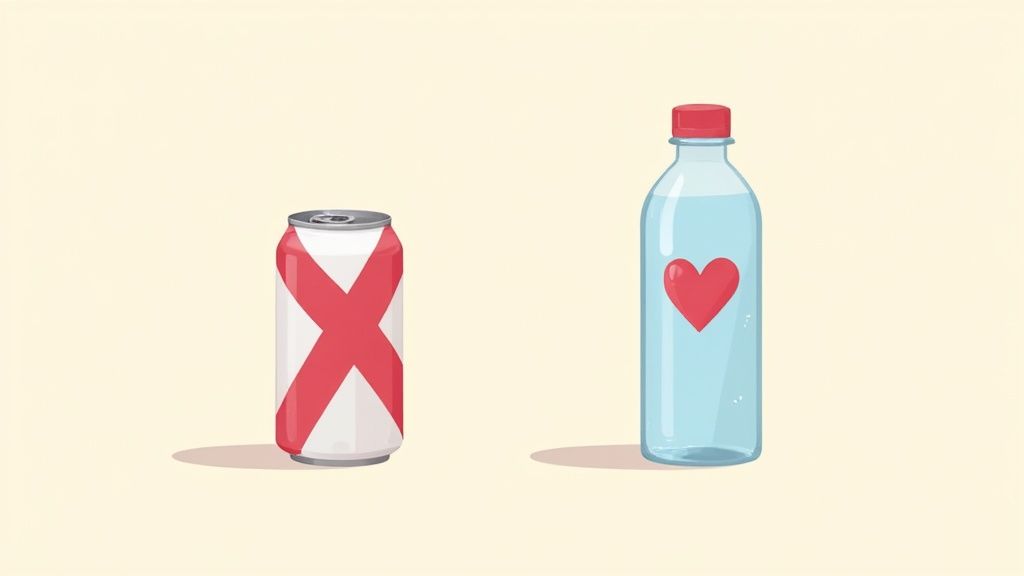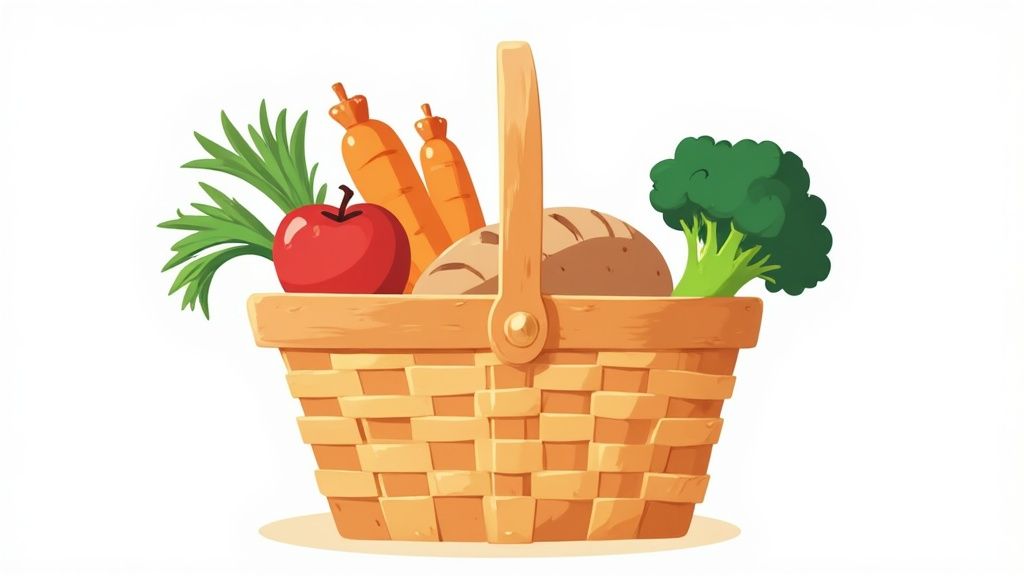8 Practical Tips for Cutting Out Sugar in 2025

The desire to reduce sugar is a common health goal, yet many find it incredibly challenging. Processed foods, hidden sugars, and powerful cravings create a cycle that feels impossible to break. The good news? It's not about superhuman willpower. It's about having the right strategies and a clear plan.
This guide provides proven, practical tips for cutting out sugar, designed to help you regain control, boost your energy, and transform your relationship with food for good. We will move beyond generic advice like "just eat less sugar" and give you actionable steps, real-world examples, and the insights you need to make lasting changes.
You will learn how to:
- Identify and avoid sugars hidden in everyday foods.
- Strategically eliminate sugary drinks, the biggest offenders in most diets.
- Manage cravings without feeling deprived.
- Build a supportive environment that sets you up for success.
Whether you want to slowly reduce your intake or eliminate added sugars completely, these tips provide a clear roadmap. We will explore how you can effectively cut down on sugar, starting today. Let's get started.
1. Read Food Labels and Identify Hidden Sugars
One of the most effective tips for cutting out sugar is to become a detective in the grocery aisle. Manufacturers are masters at hiding sugar in products you would never suspect, using dozens of different names to disguise it on the ingredients list. Learning to read food labels and identify these hidden sugars is a fundamental skill for taking control of your health and successfully reducing your sugar intake.

This practice is crucial because it moves you from passively consuming to actively choosing what goes into your body. You'll start noticing added sugars in savory items like bread, pasta sauce, salad dressings, and cured meats, not just in obvious sweets like cookies and soda.
How to Spot Hidden Sugars
Sugar goes by more than 60 different names, making it easy to overlook. Here’s a quick guide to help you identify it on any label:
- Look for words ending in "-ose": This is a classic sign of sugar. Common examples include dextrose, fructose, glucose, lactose, maltose, and sucrose.
- Watch out for syrups: Many processed foods use various syrups for sweetness and texture. Be on the lookout for high-fructose corn syrup, brown rice syrup, maple syrup, and agave nectar.
- Identify other common names: Sugar also hides under names like barley malt, cane juice crystals, corn sweetener, fruit juice concentrate, and molasses.
By familiarizing yourself with these terms, you can more accurately gauge the true sugar content of a food item, rather than just relying on the "Sugars" line in the nutrition facts panel. For a more comprehensive list and deeper insights, you can learn more about the different names for sugar on food labels.
Practical Application and Benefits
Make it a habit to scan the ingredients list of everything you buy, especially packaged and processed foods. The ingredients are listed by weight, so if you see a form of sugar in the top three ingredients, the product is likely very high in added sugar.
Pro Tip: A great rule of thumb is to favor products with five ingredients or fewer. This simple filter often eliminates highly processed foods that are typically loaded with hidden sugars, sodium, and unhealthy fats.
The primary benefit of this habit is empowerment. You gain the knowledge to make informed decisions, sidestep marketing claims on the front of the box, and truly understand what you're eating. This is a foundational step in any successful journey to cut out sugar.
2. Eliminate Sugary Beverages First
One of the most impactful tips for cutting out sugar is to target what you drink. Sugar-sweetened beverages are a primary source of added sugars in the modern diet, and eliminating them provides an immediate and significant victory. Liquid calories from sodas, sweetened juices, and energy drinks are absorbed rapidly, causing sharp spikes in blood sugar without providing the feeling of fullness that whole foods do.

Focusing on drinks first simplifies your sugar reduction journey. You can cut hundreds of empty calories and dozens of grams of sugar from your daily intake with a few simple swaps. This strategy, championed by public health initiatives like the American Heart Association, creates momentum and makes other dietary changes feel more manageable.
How to Swap Out Sugary Drinks
Transitioning away from sugary beverages doesn't have to be an all-or-nothing battle. A gradual approach can be highly effective. Here are some simple, practical swaps you can make:
- From Soda to Sparkling Water: Replace a daily can of Coke with a can of sparkling water. You'll still get the satisfying carbonation without the 39 grams of sugar. Add a squeeze of lemon or lime for flavor.
- From Juice to Whole Fruit: Instead of drinking a glass of orange juice, eat a whole orange. The fiber in the fruit slows sugar absorption and helps you feel full.
- From Flavored Lattes to Black Coffee: A medium-sized flavored latte can contain over 35 grams of sugar. Switching to black coffee or coffee with a splash of unsweetened milk dramatically cuts your sugar intake.
- From Energy Drinks to Herbal Tea: Swap high-sugar energy drinks for a glass of chilled, unsweetened herbal tea like peppermint or hibiscus for a refreshing, sugar-free lift.
Practical Application and Benefits
Start by identifying your most frequent sugary drink and finding a satisfying alternative. If you drink sweetened coffee every morning, focus on gradually reducing the amount of sugar or syrup you add over a week or two. Keep a large, reusable water bottle on your desk or with you throughout the day as a constant, visible reminder to hydrate with the best choice.
Pro Tip: Infuse a pitcher of water with fresh fruit like berries, cucumber, or mint and keep it in your fridge. This makes plain water more exciting and provides a flavorful, sophisticated alternative to sugary sodas and juices.
The key benefit here is high impact with low effort. By changing only what you drink, you can drastically reduce your overall sugar consumption, leading to better energy levels, potential weight loss, and a reduced risk of sugar-related health issues. Mastering this one area builds the confidence needed to tackle other aspects of your diet.
3. Practice Gradual Reduction Rather Than Complete Elimination
For many, the idea of quitting sugar cold turkey is overwhelming and often leads to failure. A more sustainable and effective tip for cutting out sugar is to practice gradual reduction. This method involves slowly decreasing your sugar intake over several weeks or months, allowing your body and taste buds to adapt without the intense shock, cravings, and withdrawal symptoms that often accompany abrupt elimination.

This approach is rooted in building lasting habits rather than relying on short-term willpower. By making small, incremental changes, you are less likely to feel deprived, which reduces the risk of binge-eating sugary foods and abandoning your goal. It's a compassionate strategy that focuses on progress, not perfection.
How to Implement Gradual Reduction
The key to this method is making small, manageable adjustments that you can stick with. The goal is to slowly re-calibrate your palate to appreciate less sweetness. Here are some practical examples:
- Taper your coffee or tea sugar: If you usually add two teaspoons of sugar to your morning coffee, reduce it to one and a half for a week. The following week, drop to one teaspoon, then half a teaspoon, until you can enjoy it unsweetened.
- Mix your cereals: Combine your favorite sugary cereal with a low-sugar or unsweetened alternative. Start with a 75/25 ratio (sugary/unsweetened) and gradually shift the balance each week until you are eating only the healthier option.
- Dilute sweetened beverages: If you drink fruit juice or sweetened iced tea, start by mixing it with 25% water. Increase the amount of water over time to reduce the overall sugar concentration.
These small steps are less jarring to your system and make the transition feel almost effortless, which is crucial for long-term success.
Practical Application and Benefits
To stay on track, consider focusing on one category of food or drink at a time. For instance, spend the first few weeks reducing sugar in your beverages before moving on to breakfast foods, then snacks, and finally desserts.
Pro Tip: Keep a simple journal to track your weekly goals and notice how your cravings change. Note down your small victories, like successfully drinking your coffee with less sugar for a full week. Celebrating these milestones provides positive reinforcement and keeps you motivated.
The primary benefit of this strategy is sustainability. It helps you build a new relationship with food that isn't based on restriction and deprivation. By gradually reducing sugar, you're not just fighting a craving; you're fundamentally changing your habits and preferences, making it one of the most powerful tips for cutting out sugar for good.
4. Choose Whole Foods Over Processed Alternatives
One of the most powerful and sustainable tips for cutting out sugar is to shift your focus from eliminating foods to adding them. By prioritizing whole, unprocessed foods, you naturally crowd out the processed alternatives that are typically laden with added sugars, unhealthy fats, and preservatives. This approach centers on consuming foods in their most natural state, which is a simple yet profound way to regain control over your diet.

This strategy works because whole foods like fruits, vegetables, lean proteins, and whole grains do not contain the added sugars found in packaged goods. The natural sugars present in fruits, for example, come bundled with fiber, water, vitamins, and minerals. This package slows down sugar absorption, preventing the sharp blood sugar spikes associated with processed sweets.
How to Prioritize Whole Foods
Making the switch from processed to whole foods can feel daunting, but it's easier than you think with a few simple swaps. The goal is to choose the version of a food that is closest to its origin.
- Swap flavored for plain: Instead of buying fruit-on-the-bottom or flavored yogurt, opt for plain Greek yogurt and add your own fresh berries and a sprinkle of cinnamon.
- Choose the source, not the product: Reach for a fresh apple instead of apple sauce, apple juice, or a fruit snack. The whole fruit provides fiber that promotes satiety.
- Upgrade your grains: Replace instant oatmeal packets, which often contain significant added sugar, with plain rolled or steel-cut oats. Cook them with water or milk and add your own natural toppings.
This principle, famously advocated by authors like Michael Pollan and foundational to eating styles like the Mediterranean diet, reorients your entire approach to food. You begin to see food as nourishment rather than just a convenience item.
Practical Application and Benefits
Integrating this habit into your routine can start with small, manageable steps. You don't need to overhaul your entire kitchen overnight.
Pro Tip: A simple but effective strategy is to "shop the perimeter" of the grocery store. The outer aisles are typically where you'll find fresh produce, meats, and dairy, while the inner aisles are packed with processed, shelf-stable foods high in added sugar.
Start by aiming to replace just one processed food with a whole-food alternative each week. For instance, swap your sugary breakfast cereal for scrambled eggs with spinach. The key benefit is not just sugar reduction, but also a significant increase in nutrient intake. You'll consume more fiber, vitamins, and antioxidants, leading to better digestion, more stable energy levels, and improved overall health. This is a core practice for anyone looking for effective, long-term tips for cutting out sugar.
5. Find Natural Sugar Alternatives and Flavor Enhancers
One of the most sustainable tips for cutting out sugar involves retraining your palate rather than just depriving it. Instead of eliminating sweetness entirely, you can discover natural sugar alternatives and powerful flavor enhancers that satisfy cravings without the negative health impacts of refined sugar. This strategy focuses on adding flavor and natural sweetness to your food, making your meals more enjoyable and the transition away from sugar much easier.
This approach is powerful because it addresses the root of a craving: the desire for flavor and satisfaction. By learning to use spices, extracts, and naturally sweet whole foods, you can create delicious meals and drinks that don't rely on added sugars for their appeal, helping you successfully reduce your overall sugar consumption.
How to Enhance Flavor Naturally
Your spice rack is one of your best allies in the fight against sugar. Many spices create a perception of sweetness or add such a rich, complex flavor that you won't miss the sugar.
- Embrace Warming Spices: Cinnamon, nutmeg, cloves, and cardamom are fantastic for this. Adding cinnamon to your morning coffee or oatmeal can provide a warm, sweet-like flavor that reduces or eliminates the need for sugar.
- Use Flavor Extracts: A few drops of pure vanilla, almond, or coconut extract can trick your brain into perceiving sweetness. Try adding vanilla extract to plain Greek yogurt or a smoothie for a flavor boost.
- Incorporate Naturally Sweet Vegetables: Many vegetables have a natural sweetness that can be highlighted through cooking. Roasting vegetables like sweet potatoes, butternut squash, carrots, and beets brings out their sugars, adding a satisfying sweetness to savory dishes.
By experimenting with these flavor enhancers, you can build a new taste profile that appreciates complexity over simple sweetness. For a more detailed breakdown of healthier options, you can explore the best sugar substitutes for your diet.
Practical Application and Benefits
Start small by making one simple swap. If you normally put two teaspoons of sugar in your coffee, try one teaspoon and a dash of cinnamon instead. The goal is to gradually reduce your reliance on processed sugar while amplifying other flavors.
Pro Tip: Use citrus zest to brighten up dishes and drinks. The zest from a lemon, lime, or orange adds a fresh, vibrant flavor without adding any sugar, cutting through richness and enhancing the overall taste of your food.
The key benefit here is sustainability. Instead of feeling restricted, you are expanding your culinary horizons. This method empowers you to cook more creatively and enjoy a wider range of flavors, making a low-sugar lifestyle not just manageable, but genuinely enjoyable and long-lasting.
6. Plan and Prepare Sugar-Free Meals and Snacks
One of the most powerful tips for cutting out sugar is to move from reactive eating to proactive planning. Meal planning and preparation is a cornerstone strategy that ensures healthy, low-sugar options are always within reach, effectively removing the temptation of convenient, sugar-laden processed foods. By dedicating a small amount of time to plan meals, shop for whole ingredients, and prepare foods in advance, you build a reliable defense against impulsive choices.
This practice is crucial because it addresses the moments of weakness when hunger and fatigue strike. When you have a delicious, pre-made meal or snack waiting for you, the allure of a sugary granola bar or a quick fast-food stop diminishes significantly. It’s about making the healthy choice the easy choice.
How to Implement Meal Prep for a Low-Sugar Lifestyle
Successful meal prep doesn’t have to mean cooking entire complex meals for the week. It can be as simple as preparing components that make assembling healthy meals quick and easy.
- Batch-cook staples: Cook a large batch of a lean protein like chicken breast, a versatile grain like quinoa, and roast a tray of various vegetables. These can be mixed and matched for different meals throughout the week.
- Prepare grab-and-go breakfasts and snacks: Make a batch of overnight oats with chia seeds and berries, wash and pre-cut vegetables for dipping in hummus, or portion out homemade trail mix with nuts, seeds, and unsweetened coconut flakes.
- Create a rotating menu: To avoid food fatigue, develop a two-week rotating menu of your favorite low-sugar meals. This streamlines your planning and shopping process.
This approach transforms your kitchen into a hub of healthy, ready-to-eat options, setting you up for consistent success.
Practical Application and Benefits
Dedicate just two or three hours over the weekend to your meal prep routine. Invest in quality glass food storage containers to keep food fresh and make reheating simple. This small time investment pays huge dividends in time saved and healthier choices made during a busy week.
Pro Tip: Keep "emergency snacks" on hand for unexpected hunger. A small bag of almonds, a hard-boiled egg, or a cheese stick can be a lifesaver, preventing you from reaching for a sugary alternative when your plans go awry.
The core benefit of meal prepping is control. You control the ingredients, the portion sizes, and the availability of your food. This strategic foresight is fundamental for anyone serious about creating a sustainable, low-sugar lifestyle and is one of the most effective tips for cutting out sugar for the long term.
7. Understand and Manage Sugar Cravings
A crucial step in successfully cutting out sugar is moving beyond just physical dietary changes and learning to understand your own mind. Cravings are powerful signals, but they aren't always about hunger. Learning to identify their true source and developing strategies to manage them is essential for long-term success without feeling deprived or constantly fighting a losing battle.
This tip is about becoming a detective of your own habits. Cravings can be triggered by a wide range of factors, including stress, fatigue, hormonal changes, or simply deeply ingrained routines. By understanding these patterns, you can address the root cause instead of just trying to suppress the symptom with willpower alone.
How to Identify Your Craving Triggers
The first step is observation. Cravings often follow predictable patterns. Here are common triggers to look for:
- Emotional Triggers: Do you reach for a sweet treat after a stressful work meeting or a difficult conversation? This is a common pattern where sugar is used as a coping mechanism.
- Habitual Triggers: Maybe you always have a cookie with your afternoon coffee or dessert after dinner. These cravings are often driven by routine rather than actual hunger.
- Physiological Triggers: An afternoon energy slump, dehydration, or hormonal shifts during a menstrual cycle can all manifest as intense sugar cravings.
- Social Triggers: Office birthday cakes, holiday gatherings, and nights out with friends can create pressure and trigger cravings through social norms.
By pinpointing your specific triggers, you can develop targeted strategies. For a more detailed guide, you can learn more about how to manage your sugar cravings effectively.
Practical Application and Benefits
Begin by keeping a simple "craving journal" for a week. Note when a craving hits, what you were doing, and how you were feeling. This data will quickly reveal your personal patterns.
Pro Tip: Practice the "pause and assess" technique. When a craving strikes, stop for a minute. Ask yourself: "Am I truly hungry, or am I tired, stressed, or bored?" This brief pause can be enough to break the automatic reach for sugar.
The main benefit of this approach is sustainability. Instead of relying on finite willpower, you build lasting skills to manage your emotional and physical well-being. This empowers you to respond to your body's needs in healthier ways, making your journey to cut out sugar a sustainable lifestyle change rather than a temporary diet.
8. Create a Support System and Environment
One of the most powerful yet often overlooked tips for cutting out sugar is to engineer your surroundings for success. Willpower is a finite resource, but a supportive environment and a strong social network can carry you through moments of weakness, making healthy choices the path of least resistance. This strategy involves both shaping your physical space and building a team of allies who champion your health goals.
This approach is effective because it removes the need for constant self-negotiation. When sugary snacks aren't easily accessible and your friends are cheering you on, you're less likely to fall back into old habits. It transforms the challenge from a solo battle into a collaborative effort, significantly boosting your chances of long-term success.
How to Build Your Support Structure
Creating a supportive ecosystem involves intentional actions in both your physical and social worlds. Here’s a practical guide to get you started:
- Design a "Safe" Home Environment: The first step is to control what's within arm's reach. Remove trigger foods like cookies, candy, and sugary cereals from your kitchen counters and pantry. Stock your fridge and cupboards with healthy, appealing alternatives like fresh fruit, nuts, and yogurt.
- Communicate Your Goals Clearly: Talk to your family, friends, and coworkers. Explain what you're doing and why it's important to you. Ask for specific support, such as not offering you sweets or choosing restaurants with healthier options for group outings.
- Find Your Tribe: You don't have to do this alone. Join online communities or forums dedicated to sugar-free living, or find a workout partner who shares similar health aspirations. This shared experience provides accountability and a space to exchange tips and encouragement.
By proactively managing these elements, you create a powerful buffer against temptation and a source of motivation that helps maintain your commitment.
Practical Application and Benefits
Start by taking inventory of your home and social circles. Identify the biggest sources of temptation and think of one small change you can make today. For example, move the office candy jar out of your direct line of sight or ask your partner to keep their ice cream in an opaque container.
Pro Tip: Schedule regular check-ins with an "accountability partner." This could be a friend, family member, or someone from your online support group. Sharing your weekly wins and challenges can provide immense motivation and keep you on track.
The primary benefit here is resilience. A well-designed environment and a strong support system make your journey to cut out sugar more sustainable and less stressful. You build a safety net that catches you when your personal motivation dips, ensuring that a single craving doesn't derail your entire progress.
8 Key Tips for Cutting Out Sugar Compared
| Strategy | Implementation Complexity 🔄 | Resource Requirements ⚡ | Expected Outcomes 📊 | Ideal Use Cases 💡 | Key Advantages ⭐ |
|---|---|---|---|---|---|
| Read Food Labels and Identify Hidden Sugars | Medium - requires learning many sugar names | Moderate - time and focus on labels | Increased awareness and informed choices | Interested consumers tracking sugar | Empowers informed decisions, reveals hidden sugars |
| Eliminate Sugary Beverages First | Low - relatively simple substitution | Low - just beverage replacement | Quick calorie and sugar reduction | Beginners seeking immediate impact | Immediate results, better hydration, dental health |
| Practice Gradual Reduction Rather Than Complete Elimination | Medium - needs planning and tracking | Moderate - patience and monitoring | Sustainable long-term sugar reduction | Those avoiding cravings & withdrawal | Higher success rate, prevents binges and stress |
| Choose Whole Foods Over Processed Alternatives | Medium-High - requires meal prep and shopping changes | Moderate-High - more fresh groceries | Improved nutrition and natural sugar reduction | Health-conscious prioritizing nutrition | Automatic sugar cut, better nutrition, satiety |
| Find Natural Sugar Alternatives and Flavor Enhancers | Low-Medium - learning and experimenting | Moderate - cost of specialty items | Reduced sugar intake with maintained flavor | Those wanting flavor variety & health | Satisfies cravings naturally, lowers blood sugar spikes |
| Plan and Prepare Sugar-Free Meals and Snacks | High - requires dedicated time and organization | High - time, storage, and meal prep tools | Consistent low-sugar eating, less impulsive choices | Busy individuals wanting routine | Saves time later, reduces stress, improves nutrition |
| Understand and Manage Sugar Cravings | Medium - requires mindfulness and self-awareness | Low - mostly behavioral and mental effort | Reduced impulsive sugar consumption | Those struggling with emotional eating | Addresses root causes, develops regulation skills |
| Create a Support System and Environment | Medium - involves social coordination and planning | Low-Moderate - social time and environment setup | Higher adherence and motivation | People needing accountability and community | Less reliance on willpower, social encouragement |
Your Next Step Towards a Sugar-Free Life
We’ve explored a comprehensive toolkit of eight powerful strategies designed to help you reclaim control over your diet and well-being. From becoming a detective of food labels to building a supportive environment, you now possess the knowledge needed to dismantle your reliance on added sugar. These aren't just abstract ideas; they are practical, actionable tips for cutting out sugar that can be woven into the fabric of your daily life, one intentional choice at a time.
The journey ahead isn't about achieving flawless perfection overnight. Instead, it's about making consistent, mindful progress. The most significant changes often begin with the smallest, most manageable steps.
Turning Knowledge into Action: Your Personalized Plan
The key to lasting success is to avoid feeling overwhelmed. Don't try to implement all eight strategies at once. Instead, review the tips we've covered and choose one or two that resonate most with you right now.
- If you’re a "quick win" person: Start with Tip #2: Eliminate Sugary Beverages First. This single change can drastically reduce your daily sugar intake and build immediate momentum.
- If you're a planner: Focus on Tip #6: Plan and Prepare Sugar-Free Meals and Snacks. Dedicate a few hours on the weekend to cooking. This proactive approach removes the guesswork and makes healthy choices the easy choices during a busy week.
- If you feel controlled by cravings: Dive deep into Tip #7: Understand and Manage Sugar Cravings. Start by simply observing your triggers without judgment. Is it stress? Boredom? The 3 PM slump? Awareness is the first step to developing new, healthier coping mechanisms.
Once you’ve successfully integrated your first chosen habit, come back to this list and select another. This gradual, layered approach builds a strong and sustainable foundation for a low-sugar lifestyle, preventing the burnout that often comes from trying to do too much, too soon.
The Bigger Picture: Why This Journey Matters
Mastering the art of cutting out sugar extends far beyond simply changing what you eat. It’s an investment in your long-term health, energy, and mental clarity. By moving away from processed foods and hidden sugars, you are actively reducing your risk of chronic health conditions, stabilizing your energy levels to avoid those dreaded afternoon crashes, and fostering a more positive and stable mood.
Key Takeaway: Reducing your sugar intake is one of the most powerful levers you can pull to enhance your overall quality of life. It’s not about restriction; it's about liberation from cravings and a pathway to a more vibrant, energized you.
Each time you opt for whole fruit instead of a candy bar, choose water over soda, or cook a meal from scratch, you are casting a vote for your future self. You are reinforcing the message that you deserve to feel good, to be in control, and to thrive.
The path to a low-sugar life is a personal one, filled with learning and discovery. Be patient and compassionate with yourself. There will be challenges, but with these strategies in hand, you are fully equipped to navigate them. You have the tools, the knowledge, and the power to build a healthier relationship with food. Your next step, no matter how small, is the beginning of a profound and rewarding transformation. Take it today.